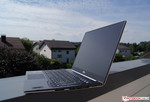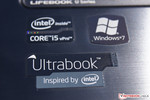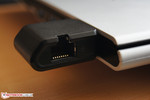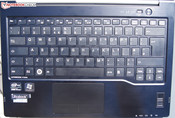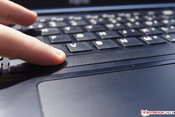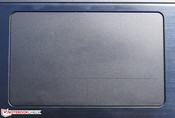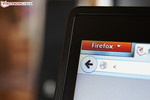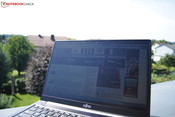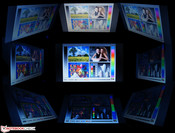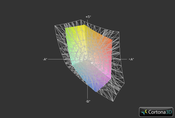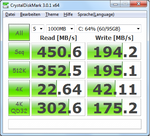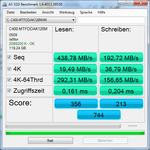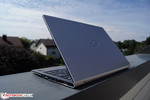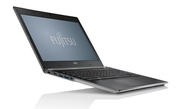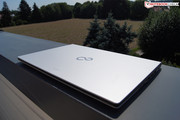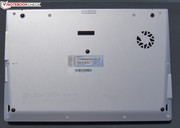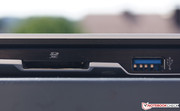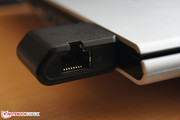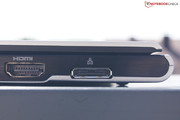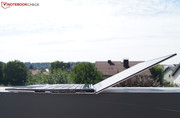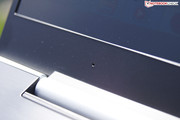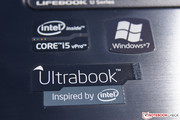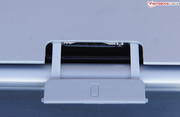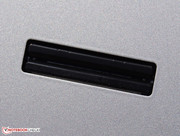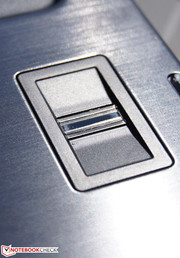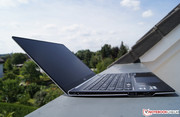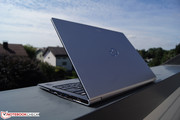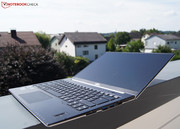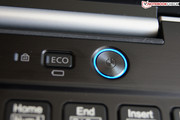Review Fujitsu LifeBook U772 Ultrabook

What is the first thing that comes to your mind when you think of ultrabooks? Slim case (perhaps metal), 13-inch screen, low weight and maybe an SSD drive besides a long battery life?
In addition to these basics, Fujitsu rather seemed focused on the idea of how to install as much hardware as possible into the laptop's smaller size while designing the Lifebook U772. Therefore, the 14-inch screen is installed in a case where rivaling manufacturers would at most use a 13-inch screen, among other things. The U772's price starts at about 1200 Euros (~$1513) depending on the configuration.
Naturally, it has to convince - the new Lifebook's target group is heavily fought over. Many manufacturers fight for supremacy in the premium price range of 1000 to 1300 Euros (~$1261 to $1639) with well-designed, elegant ultrabooks. The main competition is set up well here. Principally, it was Apple who invented the ultra-portable notebook category - long before the "Apple-less" rivals - via its MacBook Air and omitted a DVD drive for the first time in 2008. Now, besides the MacBook Air 13-inch, particularly Asus has become just as an important player in this sector with a few of its Zenbooks, e.g. UX31A or UX32VD. But Samsung also offers slim and mobile devices in the high-end sector with its Series 9 (see 900X3B-A01).
Many of these laptops feature very high-res screens with up to 1920x1080 pixels in a 13.3-inch screen size in addition to the typical ultrabook advantages. Is a 14-inch HD screen enough to at least draw even with the competition?
Case
The U772 looks very impressive when just unboxed. The first positive thing we notice when picking up the new Lifebook for the first time is its chassis' low weight of 1.4 kg (3.1 pounds). When placed on our table, the case's slimness impresses us. With a height of 1.56 cm (0.6 inches), Fujitsu's ultrabook is actually over a millimeter slimmer than the MacBook Air 13-inch. This is also the reason why the RJ45 LAN port is designed as a flatter connector.
Nevertheless, its rigidness is satisfying. The slim base is extremely stiff and even the display lid defies quite a bit of pressure considering its narrowness. In return, Fujitsu's laptop is not completely convincing in terms of feel. The display lid's magnesium surface rather has a plastic feel to it. The base unit makes a much higher-quality impression.
The U772 even manages well the test that has taught many lightweight notebooks the meaning of fear - the opening test. A tiny recess is on the lid's center front edge and intuitively indicates where the laptop can be best opened. The lid opens very easily - even with only one hand without lifting the base for one second - great! When the display is brought into position, it usually stays there immediately and stably without rocking for a long period. The long hinge's stability is immediately noticed when adjusting the opening angle precisely. The maximum opening angle of 155° is just as thrilling. Thus, it is possible to work pleasantly on the Lifebook when it's placed on the lap during a cramped train ride.
Connectivity
It is increasingly becoming untrue that ultrabooks frequently do not harbor many ports due to their chassis' slim design. The U772 does not blunder here either.
Fujitsu installs everything of distinction among interfaces. For example, two USB 3.0 ports, an HDMI socket and the mini RJ45 port as well as an SD-XC card reader are on the case's right. The power socket, Kensington lock slot, one USB 2.0 port and headphone jack are on the left. Additionally, a SIM card for the built-in UMTS modem can be inserted at the rear below the display hinge.
Since Fujitsu has primarily designed the Lifebook U772 for business customers, a docking port is also installed on the bottom and allows adding other interfaces via a docking station. Thus it is probably ahead of many competitors in this device category because they usually omit this expansion option.
Communication
The U772 proves to be communication-eager. Of course, you can connect to wired LAN not only via the included RJ45 dongle, but also wirelessly via WLAN (b/g/n - 2 x 2 Centrino 6205N) or UMTS (Sierra Wireless Gobi 3000). Intel's WLAN solution also supports the proprietary Wireless Display technology, which transmits screen content to monitors/projectors/flat screens that support this technology without cables. Bluetooth 4.0 is also on board and is covered by a dedicated Broadcom module (BCM207002).
Security
No half-measures are made here. In addition to the above mentioned port for a laptop lock, TPM (Trusted Platform Module) is installed as well as a fingerprint reader that is located in the wrist rest's lower right corner and thus cannot be enabled accidentally while typing. Besides these features, it is also possible to encrypt hard disk content. Security is ensured for this ultrabook.
Accessories
Apart from the user's manual, the PSU and the aforementioned mini LAN port dongle, a large software bundle is also included in the big box. It contains programs for Web design or photo editing as well as compression and archiving software. Currently there is unfortunately no matching port replicator for the U772 online, but will likely be available soon.
Maintenance
There are no visible screws on the Lifebook U772 and thus you cannot access the hardware on your own. Consequently, it is not possible to upgrade or exchange anything later, which is too bad.
Warranty
Fujitsu grants a standard 24-month warranty on the U772's proper functionality. A 5-year warranty extension including bring-in service costs a reasonable 65 Euros (~$82). In return, the 5-year on-site service costs a steep 290.60 Euros (~$366).
Input Devices
Keyboard
The U772 is extremely slim. Regrettably Fujitsu doesn't stop at nothing in the case of the keyboard. The first thing we noticed was the stiff keys with a very low stroke and poor feedback while typing.
Actually, the problem is quite logical: When a laptop has such a slim design, there is not much room left for the key drop beside the electronics and results in a key drop of just one millimeter (see picture below). The pressure point is just as inferior. The resistance is sometimes more and sometimes less palpable. But you never get a clear, haptic feedback whether the key was really hit. You also have to strike the keys with relatively high force.
This phenomenon is especially noticed in the space bar. When not enough pressure is applied somewhere in the center third, the chances are that the keystroke will not be accepted immediately at the first try. We thus found ourselves returning to our old, forceful typing habits while typing this review and simply pounded on every key in a hit and miss style known from keyboards of the 90s - however, we did not make as many typos then and our fingers did not ache as much due to the longer keystroke.
So the keyboard requires a very accurate and forceful typing style. A few users will likely not have as many problems in making correct inputs, but others will definitely have to reckon with a familiarization period at the beginning. The testers did not take a liking to typing on the keyboard even after extensive writing. In cases of doubt we would advise trying out the keyboard before buying.
Touchpad
The installed mouse replacement's accuracy is acceptable but can only be called middling. The surface is more smooth than rough and thus the fingers stick only occasionally.
However, the touchpad buttons certainly have to be criticized. They are, like in other modern ultrabooks, no longer dedicated and separated but are in the marked area of the touchpad itself. The keyboard's phenomenon is again found here. The pressure point is too stiff and when the button clicks, the stroke is only detected when the center is hit. Our reaction to this was that we simply placed our thumb in the center. But be careful!: This leads to erroneous entries since all too often a left click is translated as a right-click and vice versa here. Multi-touch gestures cannot be enabled in the lower right task bar in state of delivery as is usual. It is only possible indirectly via the driver menu. However, all current multi-touch gestures, such as the popular two-finger scroll, work fairly accurately.
What good touchpads could look like - and also should in our opinion - is seen in many colleagues, e.g. the Zenbooks UX31A and UX32VD. But even the U310 and U410 Ideapads, cheaper by about 300 to 500 Euros (~$378 to $630), have good input devices installed despite their much lower price.
Display
Fujitsu's idea to simply install a virtually frameless 14-inch screen in a 13-inch chassis apparently works well and looks good. It is naturally not really a frameless screen because 8 mm (0.3 inches) still separates the TN screen from the air. However, a protective layer over the display suggests an even bigger screen.
Unfortunately, the screen cannot technically compete with similarly expensive contenders due to a resolution of 1366x768. They often rely on a much higher resolution and somewhat well-illuminated screens, for example Samsung's Series 9 900X3B (1600x900) or Asus' Zenbook UX31A (1920x1080).
| |||||||||||||||||||||||||
Brightness Distribution: 87 %
Center on Battery: 196 cd/m²
Contrast: 142:1 (Black: 1.38 cd/m²)
| |||||||||||||||||||||||||
Brightness Distribution: 85 %
Center on Battery: 196 cd/m²
Contrast: 316:1 (Black: 0.62 cd/m²)
So as to the screen's technical capabilities (LG screen: LP140WH6-TS3), we can confidently speak of merely average quality. Subjectively, the representation is acceptable although it does not display really crisp colors or great contrast rates. The screen is at least matte. Nevertheless, it is not perfect for outdoor use due to the maximum average brightness of 191.4 cd/m2.
The screen responds to viewing angle changes as expected from a TN screen. Although there are no coarse color deviations seen over a long span horizontally, the colors fade when the vertical viewing angle is adjusted only moderately.
The reproduced color spectrum also does not reach the sRGB gamut as expected. The much higher resolution and brighter contenders do not manage this either. However, they are recommended for outdoor use, which is more interesting than the covered color space for ultrabook users. Graphic designers will turn to other, specialized devices anyway.
The Lifebook U772 is usually sufficiently bright for indoor and outdoor use in the shade. Subjectively, we can only criticize the occasionally slightly pixelated reproduction caused by the low resolution and the lack of overview besides the poor brightness after our check. Otherwise, the screen is absolutely sufficient for Internet browsing or office applications. Nevertheless, we think it’s too bad that Fujitsu does not completely exhaust the potential for an absolutely unique selling point in the U772 here.
Performance
Judging from only the components, the Lifebook U772 should be a really swift ultrabook. The combination of a speedy SSD storage device (Micron C400, 128 GB - identical with Crucial's M4), Intel's new Ivy Bridge Core i5-3427U processor and 2 x 2 GB of DDR3 RAM (1600 MHz, also from Micron).
And in fact, the Lifebook makes an extremely fast subjective impression in our test. No interruptions or unwanted breaks are seen even in energy-savings mode; all inputs are accepted and implemented immediately. But we definitely do not rely on our gut feeling in the performance test and look at the measured results in detail.
Processor
Like in other modern ultrabooks, an energy-saving ULV (Ultra Low Voltage) processor from Intel's latest Ivy Bridge generation is used in the Lifebook U772 (TDP: 17 Watts). The Core i5-3427U features a default clock of 2 x 1.8 GHz in addition to the Turbo Boost 2.0 technology that can accelerate single cores up to 2 x 2.8 GHz according to the load. Hyperthreading is also on board and enables processing two threads on one core per clock cycle at the same time. In particular, highly parallelized applications, such as video editing, benefit from this.
The Lifebook U772 is usually on a par with the competition. For example, it is only 1% behind the Zenbook UX32VD in Cinebench R11.5 (multithread), which however uses a weaker processor. It is also neck and neck in Cinebench R10 (64-bit single). The 13-inch MacBook Air is also only 1% faster here. However, when compared with the faster Zenbook UX32VD, it is 9% slower. Of course, their cheaper processor does not support the Lifebook's somewhat higher Turbo Boost, which is important in the single-core benchmarks. Samsung's 900X3B even lags behind by 29% due to the installed, outdated Sandy Bridge processor (CPU: Core i5-2467M, GPU: HD Graphics 3000).
The processor installed in the Lifebook thus always works very fast.
System Performance
To test the system's speed in real-world conditions, we use Futuremark's PCMark Vantage and PCMark 7. The Lifebook U772 fares quite well owing to the installed SSD and swift processor. For example, the Zenbook UX32VD (Core i5-3317U / GeForce GT 620M) does not stand a chance against our test device due to the conventional magnetic hard disk that is only "boosted" by a small SSD in PCMark Vantage (47% lower result). However, the dispersion is reduced when only looking at the contenders based on SSDs. The Zenbook UX31A (Core i5-3317U / HD Graphics 4000) achieves a 4% lower score and the 13-inch MacBook Air using the same CPU & GPU achieves a 9% better result than our Lifebook.
Our test device scores very well in PCMark 7 and even manages the 7th overall place of all previously tested laptops at the time of the test. The Zenbook UX31A is 2% faster, the MacBook Air 13-inch is 17% slower and Samsung's 900X3B is even 28% slower than the U772. The latter, featuring the Core i5-2467, however still relies on an obsolete processor including an equally obsolete, integrated graphics (HD Graphics 3000).
The overall system performance assessed using various benchmarks can thus also be called excellent.
| PCMark Vantage Result | 11577 points | |
| PCMark 7 Score | 5039 points | |
Help | ||
Storage Devices
So the overall performance is excellent. This is also largely due to the installed SSD. Micron's new C400 SSD has a capacity of 128 GB in our test device. However, the user can only use approximately 30 GB effectively after the operating system and important software has been installed. After installing all kinds of benchmarks and the listed games, we have only roughly 24.5 GB left over.
Looking at the test results of CrystalDiskMark, the SSD does a flawless job. Large amounts of data are accessed extremely fast with 451 MB/s in sequential read. The 13-inch MacBook Air using the same CPU/GPU also presents the same result in this test, but the Zenbook UX31A (i5-3317U / HD Graphics 4000) scores 6% better. Whether this slight difference is really noticed in routine use is doubtful.
However, flash-powered storage devices excel in reading small files (for example, booting the operating system or programs) compared with conventional hard disks. CrystalDiskMark's 4K read benchmark provides information about exactly this scenario. Here, a very good 22.6 MB/s is reached, but the Zenbook UX31A is again faster with 28.3 MB/s. Our test device manages an excellent 7th overall place in the 4KQD32 test and is thus the absolutely fastest ultrabook of the ultrabooks we reviewed here. It surpasses its immediate pursuer, Samsung's 900X3B (Core i5-2467M / HD Graphics 3000), by 9%. The MacBook Air 13-inch is even defeated by 55%.
The installed SSD is very fast (this is illustrated by the AS SSD benchmark on the right). Fujitsu may commend Micron as a manufacturer for this because it is doubtlessly the reason for the excellent system performance we observed.
Graphics Card
Intel's new Ivy Bridge generation includes a shrunken manufacturing process as well as the new integrated graphics solution: the HD Graphics 4000. According to Intel, it should be fast enough to accelerate even several 4K videos simultaneously (at least the desktop variant). The GPU clock of 650 MHz implemented there is however not used in our test device. We found a base clock of 350 GHz.
We believe that this IGP solution is very appropriate for ultrabooks. Since the graphics is integrated in the processor, more energy can be saved than with dedicated GPUs; the performance is now on a par with that of entry-level cards (e.g. GeForce GT 610M) or sometimes is a bit lower. Thus, you can usually enjoy many games smoothly in the lowest settings in addition to all kinds of HD videos.
Compared with the competition, the HD Graphics 4000 in the Lifebook U772 scores a lot worse than the one in the MacBook Air 13-inch, which renders 57% faster with the same processor and consequently the same GPU in 3DMark Vantage. But the Zenbook UX31A is also 21% faster despite a slightly weaker Core i5-3317U and HD Graphics 4000.
However, since the scores of the respective processor benchmarks are generally higher than those of the competition, the results suggest that Fujitsu prioritizes the processor under high load and takes the power from the graphics card to prevent the device from overheating (see screenshots below). This also makes sense in view of the ultrabook's business alignment because you more often benefit from a faster processor than from faster graphics in daily work situations.
| 3DMark 06 Standard Score | 3537 points | |
| 3DMark Vantage P Result | 2225 points | |
| 3DMark 11 Performance | 425 points | |
Help | ||
Gaming Performance
We could also only produce a rather below average graphics card performance in the tested games (all bestsellers). However, it is more striking that particularly Fujitsu ultrabooks tend to perform poorly and are the slowest laptops featuring Intel's new graphics solution that we have tested. We relate this to a comparatively poor temperature management and the consequent throttling of these devices (more about that later).
Anno 2070 exhibits smooth playability in low details and a resolution of 1024x768 with an average of 33 frames per second (fps). However, all laptops featuring the same graphics card achieve 17 to 45% faster frame rates. The MacBook Air 13-inch, with the same CPU & GPU and roughly the same settings, manages a much faster 47 fps. We would not recommend higher setting in the Lifebook because, for example, 15 fps do not enable smooth gameplay in medium details and the native resolution of 1366x768.
FIFA 12 looks the same: With 800x600 and low details, the gameplay can be followed with continuously smooth 79 fps. However, the Zenbook UX31A (Core i5-3317U, HD Graphics 4000), for example, is a whole 34% faster with 106 fps than the Lifebook. The game is fairly smooth up to medium details and a resolution of 1024x768 (49 fps). There are noticeable stutters observed in Lifebook's native resolution of 1366x768 and high details including two-time anti-aliasing due to 22 fps.
The atmospheric first-person shooter, Metro 2033, is also part of this test. It even demands quite a bit of effort from high-end systems. Our overburdened Lifebook U772 already displays a jerky presentation of 19 fps at a resolution of 800x600 and low details in DX 9 mode. So a smooth gameplay is not possible on this ultrabook. This is repeated in the result using the native resolution and medium details, where merely 9 frames per second are achieved in DX 10 mode and the game looks like a flip-book.
Verdict: The occasional game is only possible to a point and with limitations. However, if you want to use your laptop more frequently for gaming, the U772 is definitely the wrong piece of hardware.
| low | med. | high | ultra | |
|---|---|---|---|---|
| Metro 2033 (2010) | 19 | 9 | ||
| Fifa 12 (2011) | 79 | 49 | 22 | |
| Anno 2070 (2011) | 33 | 15 | 8 |
Emissions
System Noise
The U772 is pleasantly continuously quiet during routine use (i.e. Web browsing, word processing, etc.). The fan's noise is even completely canceled for the most part because it is often disabled when not needed. A minor yo-yo effect (regular on and off of the fan) was observed after a longer period of testing in energy-savings mode. However, the frequency between fan and mute phases is longer than usual and is thus not noticed as much as in other laptops.
But when the fan starts up and has a lot to do because of increasing load, the high-pitched whir of the small fan is striking as it desperately tries to discharge the produced waste heat into the surroundings. The device is not very successful in this attempt, which is why we measure a maximum of 40.1 dB(A). Alongside the high frequency, it sounds like a blow dryer. This scenario will unlikely be reached in real-life - providing you do not want to edit videos (we would discourage doing that on this device anyway). The competition cools their ultrabooks with much less noise.
We also noticed that some transistors generate a quiet hum when the PSU is connected to the device. This can get annoying after a long period in quiet surroundings, but is also noticed occasionally in other laptops.
Noise level
| Idle |
| 28 / 28 / 33.2 dB(A) |
| Load |
| 39.2 / 40.1 dB(A) |
 | ||
30 dB silent 40 dB(A) audible 50 dB(A) loud |
||
min: | ||
Temperature
Both the case's top (max. 34.8 °C) as well as the bottom (max. 33.6 °C) stays agreeably cool during low load. Thus, we can reassure all potential buyers who want to use the U772 for office tasks on their lap on the go. However, the fan's unusual air intake location has to be considered. The air intake is located on the bottom's upper left corner on the device - exactly where the left knee would normally be when used on the lap. Although it is never fully covered, the positioning doesn't seem well-considered.
The maximum temperature climbs to 44.7 °C on the top and 44.2 °C on the bottom during tests of longer full loads (Prime95 + FurMark), around the vent in the bottom's upper left corner in both cases. The rest of the ultrabook remains comparatively cool (approximately 33 °C). We now want to investigate the feared throttling, and in fact while Turbo Boost still lifted the processor to 2.1 GHz at the beginning (which is still slower than the competition) it freezes at 798 MHz after an hour of full load. The core temperatures exhibit a fairly hot 82 °C and the fan is now in the aforementioned "blow dryer" mode.
Fujitsu has apparently made cutbacks in cooling design in favor of a particularly slim chassis. We would personally have accepted a bit more weight or component density for a better cooling capacity that could harness the installed hardware in full without slowing it down. But when used in Office mode, these worries are quickly forgotten and, as the benchmarks show, the U772 belongs to the currently fastest devices on the market under these conditions.
(±) The maximum temperature on the upper side is 44.7 °C / 112 F, compared to the average of 35.9 °C / 97 F, ranging from 21.4 to 59 °C for the class Subnotebook.
(±) The bottom heats up to a maximum of 44.2 °C / 112 F, compared to the average of 39.3 °C / 103 F
(±) In idle usage, the average temperature for the upper side is 32.1 °C / 90 F, compared to the device average of 30.8 °C / 87 F.
(+) The palmrests and touchpad are reaching skin temperature as a maximum (33.8 °C / 92.8 F) and are therefore not hot.
(-) The average temperature of the palmrest area of similar devices was 28.2 °C / 82.8 F (-5.6 °C / -10 F).
Speakers
Fujitsu installs two tiny speakers on the U772's lower right and left edges. They are logically very focused on speech intelligibility (business alignment), which is also successful. However, they are not very loud due to their small size.
Nevertheless, this setting affects music enjoyment. Even the tester's smartphone provides a fuller sound than the Lifebook. We don't expect full bass from slim laptops anyway, but rather a treble-heavy sound. However, our test songs hiss and ring so extremely that it is a relief to connect our external speakers. The produced sound pacifies us again because it is absolutely balanced.
Battery Life
Power Consumption
It is very impressive how efficiently our test device manages the required energy. The U772 is content with extremely low 4.4 - 8.7 Watts when idling. The Lifebook surpasses all contenders, but then they have screens with a much higher resolution and brightness.
The 37 Watts produced during full load are a very low consumption rate in the test range of all laptops. Compared with ultrabooks that use integrated graphics, the Lifebook is pretty far back - probably also because of the somewhat larger 14-inch screen that consumes a bit more power in maximum brightness than the smaller contenders.
| Off / Standby | |
| Idle | |
| Load |
|
Key:
min: | |
Battery Runtime
We knew that the U772 would deliver good rates during low load, as a result of reading eBooks, even before the test. The Lifebook squeezes a good 9 hours 28 minutes out of the 45.3 Wh battery in the Battery Eater Reader's test with disabled network adapters and Bluetooth, minimum screen brightness and a CPU frequency set to 800 MHz (the Eco button is available for this setting). This is a good rate in the ultrabook sector, but the MacBook Air 13-inch and the Zenbook UX31A surpass this a bit with 10 hours 17 minutes and 10 hours 48 minutes using a 60 Wh battery. Therefore we doubt the manufacturer's specification of "up to 10 hours battery life". It is actually impossible to achieve this time unless you leave the laptop unused in sleep mode with disabled screen.
More interesting is our standardized WLAN browsing test where, as the name indicates, we visit predefined sites on the Web via Wi-Fi using a measured backlight of approximately 150 cd/m2 (among them YouTube HD videos). It supplies us with the best conclusions about how a laptop will behave in real-life. For an ultrabook, the Lifebook U772 manages a good time of 5 hours 17 minutes. Many of the above named contenders remain below 5 hours while the MacBook Air 13-inch lasts for at least 6 hours 3 minutes (even a bit longer using Mac OSX Lion).
The Lifebook lasts for 1 hour and 37 minutes during full load (simulated using maximum brightness, enabled Wi-Fi and Battery Eater Classic test). Both Zenbook contenders are the leaders here, going back to the mains as much an hour later (lasting over 2.5 hours).
Overall, the U772 is energy-efficient and thus reaches a good battery life.
Verdict
Perhaps you experienced similar thoughts while reading this review as we did during the test. First anticipation, because of the extremely attractive, slim and lightweight, yet very stable magnesium chassis. Then the delight about how much hardware finds room in the very tight space - including the 14-inch screen and the UMTS module. Finally the overall excellent build quality, the good and robust hinge that first looks so small, almost fragile, but nevertheless always conveys a really secure feeling when the laptop is opened.
But as sublime as the U772 seems to be, it is not without weaknesses. The 14-inch screen, fitted into a small case where the competition would sooner install a 13-inch display, could have been a unique selling point. However, due to its poor outdoor suitability and the comparatively low resolution, it is ultimately a downer.
Fujitsu seems to have accomplished its goal: one of the slimmest laptops with the most efficient use of space. But it was done without regard to losses. There is no other way that we can explain the rather disappointing keyboard in a business ultrabook. The too short and somewhat stiff keystroke that lacks palpable feedback forces the user to apply a concentrated and forceful typing style. What good are the excellent system performance and the swift storage device when inputting issues slow you down?




